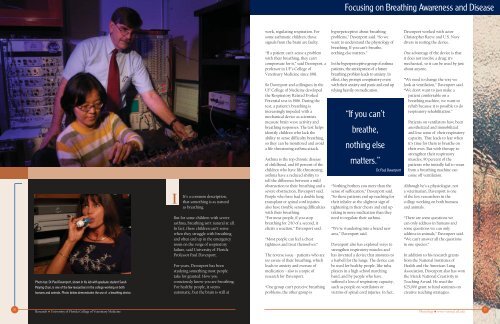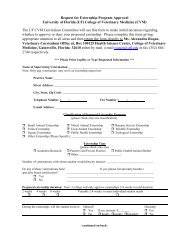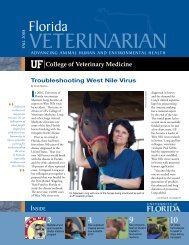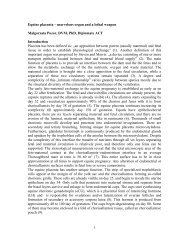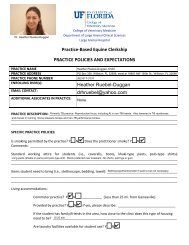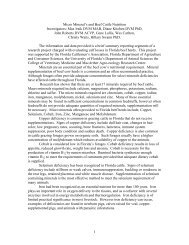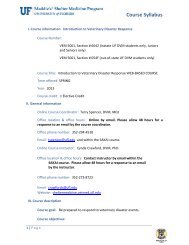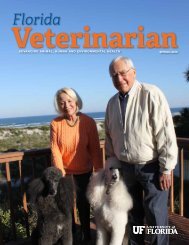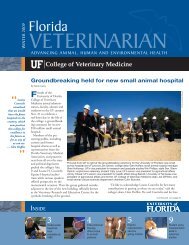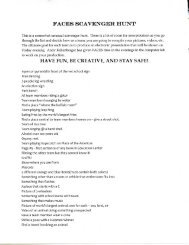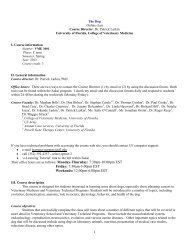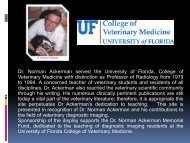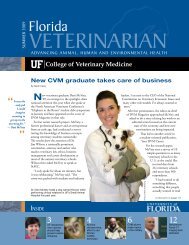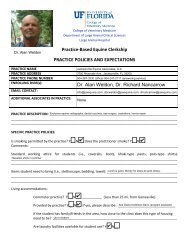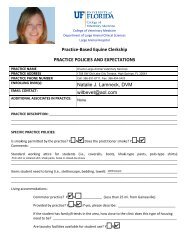College of Veterinary Medicine Research Brochure
College of Veterinary Medicine Research Brochure
College of Veterinary Medicine Research Brochure
- No tags were found...
Create successful ePaper yourself
Turn your PDF publications into a flip-book with our unique Google optimized e-Paper software.
Focusing on Breathing Awareness and DiseasePhoto top: Dr. Paul Davenport, shown in his lab with graduate student SarahPeiying Chan, is one <strong>of</strong> the few researchers in the college working on bothhumans and animals. Photo below demonstrates the use <strong>of</strong> a breathing device.IIt’s a common description,that something is as naturalas breathing.But for some children with severeasthma, breathing isn’t natural at all.In fact, these children can’t sensewhen they struggle with breathingand <strong>of</strong>ten end up in the emergencyroom on the verge <strong>of</strong> respiratoryfailure, said University <strong>of</strong> FloridaPr<strong>of</strong>essor Paul Davenport.For years, Davenport has beenstudying something most peopletake for granted: How youconsciously know you are breathing.For healthy people, it seemsautomatic, but the brain is still atwork, regulating respiration. Forsome asthmatic children, thosesignals from the brain are faulty.“If a patient can’t sense a problemwith their breathing, they can’tcompensate for it,” said Davenport, apr<strong>of</strong>essor in UF’s <strong>College</strong> <strong>of</strong><strong>Veterinary</strong> <strong>Medicine</strong> since 1981.So Davenport and colleagues in theUF <strong>College</strong> <strong>of</strong> <strong>Medicine</strong> developedthe Respiratory Related EvokedPotential test in 1986. During thetest, a patient’s breathing isincreasingly impeded with amechanical device as scientistsmeasure brain wave activity andbreathing responses. The test helpsidentify children who lack theability to sense difficulty breathing,so they can be monitored and avoida life-threatening asthma attack.Asthma is the top chronic disease<strong>of</strong> childhood, and 60 percent <strong>of</strong> thechildren who have life-threateningasthma have a reduced ability totell the difference between a mildobstruction to their breathing and asevere obstruction, Davenport said.People who have had a double lungtransplant or spinal cord injuriesalso have trouble sensing difficultieswith their breathing.“For most people, if you stopbreathing for 2/10 <strong>of</strong> a second, itelicits a reaction,” Davenport said.“Most people can feel a chesttightness and treat themselves.”The reverse issue - patients who aretoo aware <strong>of</strong> their breathing, whichleads to anxiety and overuse <strong>of</strong>medication – also is a topic <strong>of</strong>research for Davenport.“One group can’t perceive breathingproblems, the other group ishyperperceptive about breathingproblems,” Davenport said. “So wewant to understand the physiology <strong>of</strong>breathing. If you can’t breathe,nothing else matters.”In the hyperperceptive group <strong>of</strong> asthmapatients, the anticipation <strong>of</strong> a futurebreathing problem leads to anxiety. Ineffect, they prompt a respiratory eventwith their anxiety and panic and end uprelying heavily on medication.“If you can’tbreathe,nothing elsematters.”Dr. Paul Davenport“Nothing bothers you more than thesense <strong>of</strong> suffocation,” Davenport said.“So these patients end up reaching fortheir inhaler at the slightest sign <strong>of</strong>tightening in their chests and end uptaking in more medication than theyneed to regulate their asthma.“We’re wandering into a brand newarea,” Davenport said.Davenport also has explored ways tostrengthen respiratory muscles andhas invented a device that amounts toa barbell for the lungs. The device canbe used for healthy people, like tubaplayers in a high school marchingband, and by people who havesuffered a loss <strong>of</strong> respiratory capacity,such as people on ventilators orvictims <strong>of</strong> spinal cord injuries. In fact,Davenport worked with actorChristopher Reeve and U.S. Navydivers in testing the device.One advantage <strong>of</strong> the device is thatit does not involve a drug; it’smechanical, so it can be used by justabout anyone.“We need to change the way welook at ventilation,” Davenport said.“We don’t want to just make apatient comfortable on abreathing machine, we want torehab because it is possible to dorespiratory rehabilitation.”Patients on ventilators have beenanesthetized and immobilizedand lose some <strong>of</strong> their respiratorycapacity. That leads to fear whenit’s time for them to breathe ontheir own. But with therapy tostrengthen their respiratorymuscles, 90 percent <strong>of</strong> thepatients who initially fail to weanfrom a breathing machine cancome <strong>of</strong>f ventilation.Although he’s a physiologist, nota veterinarian, Davenport is one<strong>of</strong> the few researchers in thecollege working on both humansand animals.“There are some questions wecan only address in humans andsome questions we can onlyaddress in animals,” Davenport said.“We can’t answer all the questionsin one species.”In addition to his research grantsfrom the National Institutes <strong>of</strong>Health and the American LungAssociation, Davenport also has wonthe Merck National Creativity inTeaching Award. He used the$25,000 grant to fund seminars oncreative teaching strategies.26<strong>Research</strong> • University <strong>of</strong> Florida <strong>College</strong> <strong>of</strong> <strong>Veterinary</strong> <strong>Medicine</strong>••Physiology • www.vetmed.ufl.edu27


